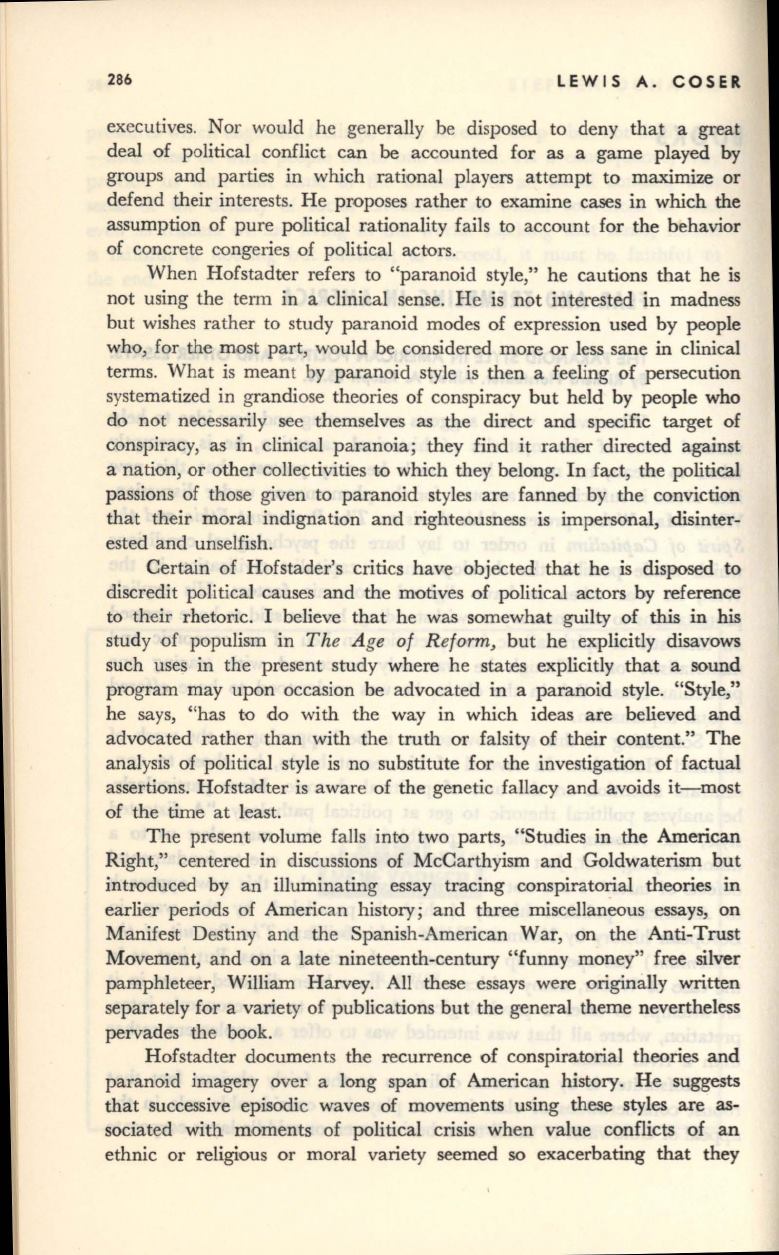
286
LEWIS A. COSER
executives. Nor would he generally be disposed to deny that a great
deal of political conflict can be accounted for as a game played by
groups and parties in which rational players attempt to maximize or
defend their interests. He proposes rather to examine cases in which the
assumption of pure political rationality fails to account for the behavior
of concrete congeries of political actors.
When Hofstadter refers to "paranoid style," he cautions that he is
not using the term in a clinical sense. He is not interested in madness
but wishes rather to study paranoid modes of expression used by people
who, for the most part, would be considered more or less sane
in
clinical
terms. What is meant by paranoid style is then a feeling of persecution
systematized in grandiose theories of conspiracy but held by people who
do not necessarily see themselves as the direct and specific target of
conspiracy, as in clinical paranoia; they find it rather directed against
a nation, or other collectivities to which they belong. In fact, the political
passions of those given to paranoid styles are fanned by the conviction
that their moral indignation and righteousness is impersonal, disinter–
ested and unselfish.
Certain of Hofstader's critics have objected that he is disposed to
discredit political causes and the motives of political actors by reference
to their rhetoric. I believe that he was somewhat guilty of this in his
study of populism in
The Age of Reform,
but he explicitly disavows
such uses in the present study where he states explicitly that a sound
program may upon occasion be advocated in a paranoid style. "Style,"
he says, "has to do with the way in which ideas are believed and
advocated rather than with the truth or falsity of their content." The
analysis of political style is no substitute for the investigation of factual
assertions. Hofstadter is aware of the genetic fallacy and avoids it-most
of the time at least.
The present volume falls into two parts, "Studies in the American
Right," centered in discussions of McCarthyism and Goldwaterism but
introduced by an illuminating essay tracing conspiratorial theories in
earlier periods of American history; and three miscellaneous essays, on
Manifest Destiny and the Spanish-American War, on the Anti-Trust
Movement, and on a late nineteenth-century "funny money" free silver
pamphleteer, William Harvey. All these essays were originally written
separately for a variety of publications but the general theme nevertheless
pervades the book.
Hofstadter documents the recurrence of conspiratorial theories and
paranoid imagery over a long span of American history. He suggests
that successive episodic waves of movements using these styles are as–
sociated with moments of political crisis when value conflicts of an
ethnic or religious or moral variety seemed so exacerbating that they


